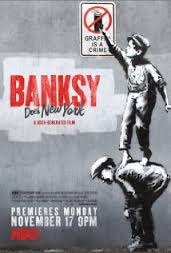
BANKSY DOES NEW YORK
US, 2014, 79 minutes, Colour.
Directed by Chris Moukarbel.
One of the best-kept secrets in the world of art, or at least the world of graffiti and street art, is the identity of the British artist called Banksy. In this age of instant social media, it is amazing that over the years the identity of Banksy has not been revealed.
In 2010, there was an intriguing documentary called Banksy, Exit through the Gift Shop, a tantalising quest for the identity of Banksy but an opportunity to look at his Street Art, respond pro or con, and a chance to think about the nature of this kind of art, ephemeral or permanent, art or kitsch.
Now, several years later, Banksy is still a mystery. He is given a commission to spend a month in New York City, October 2013. He has contracted to do a piece of art each day, and fulfils the promise except for one day when the police obstruct his work.
The film makers, with no official connection with Banksy, take the opportunity to photograph each of the works of art, quite important since a number of them were removed or defaced. Mayor Bloomberg of New York City, other officials and the police, take a dim view of this work, considering it a criminal offence to deface buildings with this kind of art and graffiti. The police are in pursuit and try to prevent further art events.
Audiences may be in two minds about the work itself, but the variety of art-words and art-images, actual graffiti, actual paintings and, even a brick sculpture, the Sphinx, have an immediately arresting quality. Some of the New York papers decided to ignore Banksy. One critic, with a touch of the pontificating, dismisses the work as unsubtle, kitsch and hammering home social messages. A more benign commentator is inclined to offer more favourable perspectives. On the other hand, television news across the broad range are continually commenting on the artist, his work, and public response. It makes for instant television
What is intriguing is that each day Banksy goes to an unknown location and does his work of art. There are many Banksy fans who want to see each work each day and a number who refer to themselves as Banksy Hunters, tweeting, using Facebook and Instagram, to let people know where they might find the works with crowds hurrying there. On the other hand, on one day, a stall is set up to sell Banksy works and people pass by, only a few purchasing the art – for about $50 each, which may then be worth thousands later!
The film captures the ideas and responses of many of the enthusiasts and the Hunters. Audiences can check their own responses in comparison.
Some of the works are quite simple, there is a frequent use of black silhouettes interacting with local objects like fire hydrants, with fans getting their photographs taken in front of the works. One of the most striking is a large art piece reflecting on the WikiLeaks? revelation about American forces and helicopters in Iraq shooting down agents as well as innocent bystanders with shockingly callous remarks. It is well worth Banksy doing a work visualising the implications of this vicious event.
The film is short, but always interesting, our listening to the views, watching the reactions of the fans, and the opportunity to see the variety of works and build up an impression of and response to Banksy.
1. Who is Banksy? The mystery? Very well-kept secret?
2. Audience response to Street Art? In the United Kingdom over the years? Art and graffiti? Kitsch? Messages through street art, dramatic? Subtle or unsubtle?
3. Banksy fans, Banksy hunters, banks the dealers? Photographing and filming his street art? Sales?
4. New York, the views of the city, familiar, unfamiliar, the details of the location for the street art? Musical score?
5. Banksy in New York for one month? The indication of the days and counting? The mystery of where he would work, when? People tracking him down, Tweeting, Instagram, Facebook? Gathering to look at the work?
6. The range of comments of the observers and the fans, the means of discovering where the art was?
7. The range, words, images, social concern, philosophers’ sayings? The puppets in the truck? The WikiLeaks? images from Iraq, and the shooting of agents and people from the helicopter? The large painting dramatising this? The use of silhouettes, the characters? The scenes of selling the art in the street, the few customers?
8. The quality of the work, its impact, those who liked it, the art critics who disliked it and condemned it?
9. The New York authorities, Mayor Bloomberg, the police, highlighting that graffiti was a crime? The police and their antagonism towards the work, defacing it, bringing it down?
10. The newspaper reports, the television news, the highlights, the mystery, the commentary? Critics, for and against?
11. The dealer, his gallery, his going to visit the men who took the Sphinx, the discussions, the deals, his option, not selling the Sphinx?
12. The opening with the stealing of the artwork, the arrest of the men? Others taking the art on doors? The image of the Sphinx and those stealing it?
13. Banksy and street art as a contemporary phenomenon? Audiences enjoying watching it and the film? Judgement on the art – and Banksy in himself and his skills?